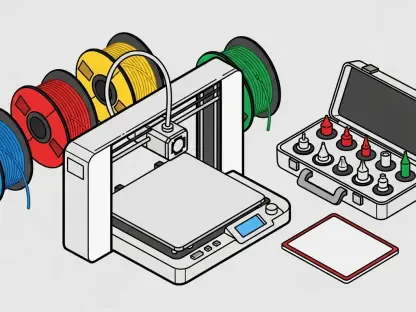In an era where technology evolves at breakneck speed, the rise of deepfake technology, fueled by generative artificial intelligence (AI), has introduced a chilling new dimension to cybersecurity challenges, especially within the manufacturing sector. These hyper-realistic synthetic videos and audio clips, crafted to impersonate real individuals with uncanny precision, are no longer a distant sci-fi concept but a tangible threat disrupting industries. Cybercriminals exploit deepfakes to orchestrate fraud, extract sensitive data, and sow chaos in operations, with over 105,000 attacks reported globally in 2024 alone. Manufacturing, with its intricate web of global supply chains and reliance on digital trust, finds itself particularly vulnerable. This exploration uncovers how these AI-driven deceptions are reshaping cyber risks, exposing systemic weaknesses, and demanding urgent adaptive strategies to safeguard a critical industry.
Unpacking the Scope of Synthetic Deception
Scale and Sophistication of Attacks
The sheer volume of deepfake attacks marks a seismic shift in the cybercrime landscape, with more than 105,000 incidents recorded in 2024, translating to a staggering frequency of one every five minutes. Generative AI serves as the backbone of this menace, empowering attackers to produce synthetic media so realistic that distinguishing fact from fiction becomes a daunting task. Unlike earlier cyber threats that relied heavily on technical exploits, deepfakes target human psychology, exploiting trust in familiar voices or faces. This sophistication allows even novice criminals to execute high-impact scams, from impersonating executives to fabricating emergency scenarios. The rapid evolution of these tools signals a broader trend: deception is no longer a niche tactic but a mainstream weapon in the arsenal of malicious actors, posing unprecedented challenges to industries like manufacturing where trust underpins daily operations.
Beyond the numbers, the technical accessibility of deepfake creation amplifies the threat on a global scale. Advanced algorithms, once the domain of specialized researchers, are now embedded in user-friendly applications, enabling attackers to generate convincing content with minimal effort or expertise. This proliferation means that small-scale fraudsters and organized crime groups alike can deploy deepfakes to manipulate employees into unauthorized transactions or data disclosures. In manufacturing, where decisions often hinge on swift communication across borders, the risk of falling prey to such meticulously crafted illusions grows exponentially. The convergence of scale and sophistication underscores an urgent need for heightened vigilance, as the line between reality and fabrication continues to blur at an alarming rate, threatening operational stability across the sector.
Emerging Tactics in Deception
The tactical ingenuity behind deepfake attacks reveals a calculated shift toward exploiting human vulnerabilities over system weaknesses. Cybercriminals often pair synthetic media with traditional social engineering methods, such as phishing, to create multi-layered scams that are harder to detect. For instance, a fabricated video call from a supposed CEO could be preceded by a spoofed email, reinforcing the illusion of legitimacy. This hybrid approach preys on the instinctive trust employees place in visual and auditory cues, bypassing even well-intentioned skepticism. Manufacturing firms, reliant on constant digital exchanges, face heightened exposure to these blended threats, where a single lapse in judgment can cascade into significant breaches or disruptions.
Moreover, the customization of deepfake content to specific targets adds another layer of danger, as attackers tailor their fabrications to exploit personal or professional contexts. By scraping publicly available media or internal communications, criminals can mimic not just appearances but also mannerisms and speech patterns, crafting scenarios that feel disturbingly authentic. This precision turns routine interactions into potential minefields, especially in an industry where remote coordination is the norm. The growing adaptability of these tactics signals a future where deception becomes increasingly personalized, challenging existing security frameworks to keep pace with an ever-shifting threat landscape that thrives on human error.
Vulnerabilities in the Manufacturing Landscape
Operational and Resource Challenges
Manufacturing’s operational model, built on intricate global supply chains and relentless digital communication, creates fertile ground for deepfake-driven cyber threats to take root. Teams spread across time zones coordinate via emails, video conferences, and instant messaging, often under tight deadlines that prioritize speed over scrutiny. This environment offers numerous entry points for attackers wielding synthetic media to impersonate trusted contacts, tricking employees into divulging sensitive information or approving fraudulent transactions. The inherent trust in these interactions, vital for seamless workflows, becomes a liability when faced with hyper-realistic deceptions that can mimic a vendor’s voice or a manager’s likeness with startling accuracy, amplifying the risk of costly missteps.
Compounding this issue is the stark disparity in cybersecurity resources, particularly among smaller manufacturing firms, which represent over 90% of breach victims as noted in Verizon’s latest Data Breach Investigations Report. Many of these organizations lack dedicated IT teams or advanced security infrastructure, leaving them ill-equipped to counter sophisticated deepfake attacks. Budget constraints often force a focus on production over protection, sidelining investments in training or technology that could mitigate risks. This resource gap not only heightens exposure but also delays recovery from incidents, as smaller entities struggle to absorb the financial and reputational fallout of a breach. Addressing this imbalance remains a critical hurdle in fortifying the sector against an escalating wave of AI-powered deception.
Primary Attack Vectors
Email emerges as a dominant gateway for deepfake-driven social engineering, exploiting the manufacturing sector’s heavy reliance on digital correspondence for daily operations. Despite its ubiquity, nearly half of companies lack robust protections like DMARC policies, creating exploitable gaps for attackers to deliver convincing fake media or spoofed messages. A deepfake audio clip embedded in a seemingly legitimate email can prompt urgent actions, such as fund transfers, under the guise of executive authority. This vulnerability transforms a routine communication tool into a weapon, where the blend of synthetic content and familiar formats undermines even cautious scrutiny, driving up the success rate of deception campaigns.
Beyond email, the integration of deepfakes with other platforms, such as video conferencing tools, further complicates the threat landscape in manufacturing. As remote work and virtual meetings remain staples of global coordination, attackers exploit these channels to stage real-time impersonations that prey on visual trust. The absence of standardized verification protocols across these platforms exacerbates the risk, allowing fabricated interactions to slip through undetected. Coupled with the sector’s fast-paced decision-making culture, this multi-vector approach ensures that deepfakes can infiltrate through various touchpoints, necessitating a comprehensive overhaul of security practices to seal off these pervasive entry points.
Real-World Consequences and Lessons
High-Stakes Fraud Cases
The tangible impact of deepfake technology on manufacturing and related sectors is vividly illustrated by staggering fraud cases that have rocked the business world. In Hong Kong, a devastating incident saw an employee deceived into transferring $25.6 million after participating in a video conference with deepfaked participants posing as company executives. The seamless realism of the fabricated visuals overrode any suspicion, leading to a catastrophic financial loss. Such events expose the raw power of synthetic media to manipulate human judgment, particularly in high-pressure environments where quick decisions are routine. The ripple effects extend beyond immediate monetary damage, shaking confidence in digital interactions that are the lifeblood of modern industry coordination.
Another alarming case involved a bank employee wiring $35 million after receiving an AI-generated voice call that perfectly mimicked a senior leader’s tone and urgency. This incident underscores how auditory deepfakes can exploit trust in familiar voices to bypass procedural safeguards, even in regulated environments. For manufacturing, where verbal confirmations often supplement written directives, the implications are dire—operational disruptions and eroded stakeholder trust can follow such breaches. These real-world examples serve as stark warnings, highlighting the urgent need for robust countermeasures to prevent similar disasters from crippling firms already navigating tight margins and complex logistics.
Long-Term Reputational Damage
The fallout from deepfake attacks extends far beyond immediate financial losses, inflicting deep wounds on a company’s reputation that can take years to heal. When stakeholders—be they clients, suppliers, or investors—learn of a breach involving synthetic deception, confidence in the organization’s reliability and security practices often plummets. In manufacturing, where partnerships hinge on trust and consistency, such incidents can trigger a domino effect, leading to lost contracts or strained vendor relationships. The public nature of high-profile frauds amplifies this damage, as media coverage casts a long shadow over the firm’s standing in a competitive market.
Moreover, the erosion of internal morale poses an equally significant challenge following a deepfake-driven breach. Employees, already under pressure to maintain productivity, may grapple with self-doubt or fear of further deception, undermining workplace cohesion. Rebuilding this trust requires transparent communication and visible investment in security, yet smaller manufacturers often lack the resources for such recovery efforts. The lingering stigma of being a target can deter future business opportunities, cementing the notion that deepfake attacks are not just transactional threats but existential risks to an organization’s credibility and long-term viability.
Strategies for Building Resilience
Cultural and Technological Shifts
Combating the scourge of deepfake threats in manufacturing demands a fundamental cultural shift toward a zero-trust mindset, where every interaction is questioned, and verification is non-negotiable. This approach challenges the instinctive reliance on familiar faces or voices, encouraging staff to adopt skepticism as a default stance, even in seemingly routine communications. Training programs play a pivotal role here, with techniques like “prebunking” equipping employees to spot telltale signs of synthetic media, such as unnatural facial movements or discrepancies in voice-lip synchronization. By fostering this awareness, firms can transform their workforce into a first line of defense against deception that exploits human trust.
Technological adjustments are equally critical, starting with efforts to limit the raw material available for deepfake creation. Restricting public exposure of executive media—videos, speeches, or images—reduces the data pool attackers can draw from to craft convincing fakes. Additionally, integrating advanced authentication protocols for sensitive communications ensures an extra layer of scrutiny, deterring casual fraud attempts. Manufacturing entities must prioritize these dual shifts, blending a culture of doubt with tech-driven safeguards, to erect barriers against an evolving threat that thrives on exploiting both human and systemic vulnerabilities.
Layered Security and Response Planning
A robust defense against deepfake attacks hinges on deploying layered security measures that address multiple facets of the threat landscape. Strengthening email security stands as a foundational step, given its prominence as an attack vector; implementing strict DMARC policies and advanced filtering can intercept spoofed messages before they reach vulnerable employees. Behavior-based monitoring tools offer another critical shield, flagging anomalous actions—like sudden large transactions—that may indicate a deepfake-induced scam. These overlapping protections ensure that no single point of failure can compromise the entire system, providing manufacturing firms with a more resilient framework to withstand sophisticated deception.
Equally vital is the development of updated incident response plans tailored to the unique nature of synthetic media threats. Such plans must outline clear steps for containment and recovery, ensuring rapid isolation of breaches to minimize damage. Post-incident analysis should focus on identifying exploited weaknesses, whether in training or technology, to prevent recurrence. By combining proactive security layers with reactive preparedness, manufacturing organizations can mitigate the impact of deepfake attacks, safeguarding their operations against a menace that shows no sign of abating. These comprehensive efforts, enacted with urgency, reflect the industry’s resolve to adapt and endure in a landscape reshaped by AI-driven deceit.









